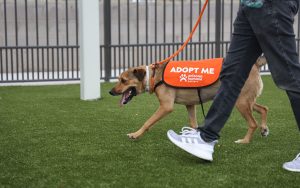
Arizona Humane Society public relations and social media manager Joe Casados holds a dog up for adoption on Feb. 1, 2024. (Photo by Crystal Aguilar/Cronkite News)
PHOENIX – Dogs waiting to be adopted from the Arizona Humane Society can be taken out of the facilities for a couple of hours prior to the shelter opening. A volunteer comes into the shelter and signs up to take a dog out on a field trip in an attempt to raise its chances of being adopted.
“A program like a doggy field trip is so amazing and important because it gives them some time outside of a kennel,” said Joe Casados, public relations and social media manager at the Arizona Humane Society. “It also just gets them outside in the community that someone who might be thinking of getting a dog but maybe hasn’t come into the Humane Society has now been introduced to this cute dog on a walk and that’s going to get them interested maybe in that dog particularly or just to come in and check out the Arizona Humane Society and see what other dogs we have available.”

Tiffany models the “Adopt Me” vest that dogs out on field trips wear to help them gain more exposure. (Photo by Crystal Aguilar/Cronkite News)
The program is new to the Arizona Humane Society this year and coincides with an influx of dogs at the organization’s shelters.
Due to COVID-19, shelters nationwide missed an estimated 3 million spay and neuter surgeries, Casados said. The organization saw 22,000 pets coming through its doors in 2023 alone, with about half of those being dogs. That’s about 20% higher than the shelter’s intake in a typical year and the busiest year the shelter has seen in a decade.
COVID was also a popular time for pet adoptions, which led to many dog surrenders once it came time for people to return to work and the realization that they weren’t able to care for them any longer.
In January, the Arizona Humane Society tested the field trip program, with select volunteers taking dogs out on weekends before opening hours. After volunteers’ positive feedback and the dogs’ happier demeanors, the program was officially launched to allow any volunteer to sign up online to take a dog out on a field trip.
The only requirements are for volunteers to be 21 or older and to have a valid identification to present to the shelter.
Volunteers are given a backpack filled with essentials for these field trips. A message on the backpack reads: “We are on a field trip. You can adopt this dog. (It’s okay to be excited).” Inside, there are supplies such as a pet seatbelt, an “Adopt Me” dog vest, a map of local dog-friendly places to visit, treats, toys and adopt-me cards for volunteers to write the dog’s name and identification number so anyone interested can go to the shelter and easily find that specific dog.
Casados said the shelter assigns dogs to guarantee the same dog isn’t being picked each time. Staff also like to ensure the dogs that are getting the extra exposure are the ones that have been in the shelter the longest or are exhibiting signs of kennel stress and could benefit from outside time.
However, the shelter does want it to be a fun experience for both parties, so volunteers are able to set their own boundaries on dog size or preference for the kind of activity they would like to do, whether it be a hike or a trip back home to cuddle and stay indoors.
There have been numerous cases already of dogs being adopted only days after their field trip outing, Casados said, though exact numbers are not available for the still-new program.

The Arizona Humane Society Papago Park Campus recently opened at 5501 E. Van Buren St. in Phoenix. Photo taken on March 14, 2024. (Photo by Crystal Aguilar/Cronkite News)
Lisa Gunter, assistant professor of animal behavior and welfare at Virginia Tech, said she has studied benefits of different types of fostering, such as these short field trips, sleepovers and weekly stays at homes.
Though dogs don’t get the type of rest and recharge from these short outings compared to the longer ones, they become five times more likely to be adopted following field trips, she said.
“People can envision their life with these dogs (when seen on a field trip) versus in the animal shelter sometimes because the animal shelter is a stressful place, and that’s sometimes hard for dogs to show their best selves in that situation,” Gunter said.
Casados agreed these field trips are great moments for potential owners to view the dogs because of how different dogs’ personalities are the second they leave the facilities.
“A dog that might be very shy and timid and maybe uninterested while it’s in its kennel, the second it’s out on a leash, a walk or car ride, you have the most bubbly, happy, friendly and ready-to-play dog, so I think people get to see the pet’s full personality when they’re out on these field trips, and that’s a lot easier to gauge whether or not that pet is going to fit your lifestyle and your family versus walking up and down a row of kennels,” Casados said.
He said taking a dog out for a trip and returning it can be a sad experience for volunteers, but it could lower a dog’s time from a few months to a few days following a field trip.

